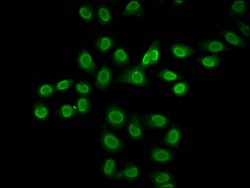Promotional price valid on web orders only. Your contract pricing may differ. Interested in signing up for a dedicated account number?
Learn More
Learn More
Formyl-Histone H2B (Lys116) Polyclonal Antibody, Invitrogen™
Rabbit Polyclonal Antibody
Supplier: Thermo Scientific PA5112476

Description
Histones are basic nuclear proteins that are responsible for the nucleosome structure of the chromosomal fiber in eukaryotes. Nucleosomes consist of approximately 146 bp of DNA wrapped around a histone octamer composed of pairs of each of the four core histones (H2A, H2B, H3, and H4). The nucleosomes wrap further and compact DNA into chromotin, limiting DNA accessibility to the cellular machineries which require DNA as a template. Histones play a central role in transciption regulation, DNA repair, DNA replication, and chromosomal stability. H2B has a broad antibacterial activity.
Specifications
| Formyl-Histone H2B (Lys116) | |
| Polyclonal | |
| Unconjugated | |
| H2BC4 | |
| 2610022J01Rik; Acetyl-Histone H2; AV127319; bA317E16.3; CG17949; CG17949-PA; CG33868; CG33868-PA; CG33870; CG33870-PA; CG33872; CG33872-PA; CG33874; CG33874-PA; CG33876; CG33876-PA; CG33878; CG33878-PA; CG33880; CG33880-PA; CG33882; CG33882-PA; CG33884; CG33884-PA; CG33886; CG33886-PA; CG33888; CG33888-PA; CG33890; CG33890-PA; CG33892; CG33892-PA; CG33894; CG33894-PA; CG33896; CG33896-PA; CG33898; CG33898-PA; CG33900; CG33900-PA; CG33902; CG33902-PA; CG33904; CG33904-PA; CG33906; CG33906-PA; CG33908; CG33908-PA; CG33910; CG33910-PA; dJ160A22.3; dJ193B12.2; dJ221C16.3; dJ221C16.6; dJ221C16.8; dJ97D16.4; Dmel\CG17949; Dmel\CG33868; Dmel\CG33870; Dmel\CG33872; Dmel\CG33874; Dmel\CG33876; Dmel\CG33878; Dmel\CG33880; Dmel\CG33882; Dmel\CG33884; Dmel\CG33886; Dmel\CG33888; Dmel\CG33890; Dmel\CG33892; Dmel\CG33894; Dmel\CG33896; Dmel\CG33898; Dmel\CG33900; Dmel\CG33902; Dmel\CG33904; Dmel\CG33906; Dmel\CG33908; Dmel\CG33910; Dmel_CG17949; Dmel_CG33868; Dmel_CG33870; Dmel_CG33872; Dmel_CG33874; Dmel_CG33876; Dmel_CG33878; Dmel_CG33880; Dmel_CG33882; Dmel_CG33884; Dmel_CG33886; Dmel_CG33888; Dmel_CG33890; Dmel_CG33892; Dmel_CG33894; Dmel_CG33896; Dmel_CG33898; Dmel_CG33900; Dmel_CG33902; Dmel_CG33904; Dmel_CG33906; Dmel_CG33908; Dmel_CG33910; fj05g08; GL105; H2B; H2B 291A; H2B 291B; H2b 613; H2B clustered histone 1; H2B clustered histone 15; H2B clustered histone 17; H2B clustered histone 19; H2B clustered histone 2, pseudogene; H2B clustered histone 21; H2B clustered histone 5; H2B clustered histone 8; H2B GL105 antibody; H2B histone family member M; H2B histone family member W testis-specific; H2B histone family member W, testis specific; H2B histone family, member A; H2B histone family, member B; H2B histone family, member C; H2B histone family, member D; H2B histone family, member E; H2B histone family, member F; H2B histone family, member J; H2B histone family, member K; H2B histone family, member L; H2B histone family, member M; H2B histone family, member N; H2B histone family, member Q; H2B histone family, member R; H2B histone family, member S; H2B histone family, member T; H2B histone family, member U, (testis-specific); H2B histone family, member W, testis-specific; H2B I; H2B II; H2B III; H2B IV; H2B K; H2B type 12; H2B VI; H2B VII; H2B.1; H2B.1 antibody; H2B.1A; H2B.1B; H2B.2; H2B.U histone 1; H2B.W histone 1; H2B/a; H2B/b; H2B/c; H2B/d; H2B/e; H2B/f; H2B/g; H2B/h; H2B/I; H2B/j; H2B/k; H2B/l; H2B/n; H2B/o; H2B/q; H2B/r; H2B/S; H2B/t; H2B1; H2B1.1; H2B1.2; h2B-143; H2B2; H2b-221; H2b-291b; H2b-613; H2Bb; H2BC1; H2BC10; H2BC15; H2BC17; H2BC19; H2BC21; H2BC2P; H2BC4; H2BC5; H2BC6; H2BC7; H2BC8; H2b-f; H2BFA; H2BFAiii; H2BFB; H2BFC; H2BFD; H2BFE; H2BFF; H2BFG; H2BFH; H2BFJ; H2BFK; H2BFL; H2BFM; H2BFN; H2BFO; H2BFQ; h2bfr; H2BFS; H2BFT; H2BFU; H2BFWT; H2BGL105; H2B-I; H2B-II; H2B-III; H2B-IV; H2BJ; H2b-j; H2BK; H2BK12ac; H2BK15ac; H2BK5ac; H2b-l; H2b-n; H2BQ; H2BS14; H2BS14p; H2BU1; H2B-VI; H2B-VII; H2BW1; HIRA-interacting protein 1; HIRA-interacting protein 2; HIRIP1; HIRIP2; His2B; His2B:CG17949; His2B:CG17949-PA; His2B:CG33868; His2B:CG33868-PA; His2B:CG33870; His2B:CG33870-PA; His2B:CG33872; His2B:CG33872-PA; His2B:CG33874; His2B:CG33874-PA; His2B:CG33876; His2B:CG33876-PA; His2B:CG33878; His2B:CG33878-PA; His2B:CG33880; His2B:CG33880-PA; His2B:CG33882; His2B:CG33882-PA; His2B:CG33884; His2B:CG33884-PA; His2B:CG33886; His2B:CG33886-PA; His2B:CG33888; His2B:CG33888-PA; His2B:CG33890; His2B:CG33890-PA; His2B:CG33892; His2B:CG33892-PA; His2B:CG33894; His2B:CG33894-PA; His2B:CG33896; His2B:CG33896-PA; His2B:CG33898; His2B:CG33898-PA; His2B:CG33900; His2B:CG33900-PA; His2B:CG33902; His2B:CG33902-PA; His2B:CG33904; His2B:CG33904-PA; His2B:CG33906; His2B:CG33906-PA; His2B:CG33908; His2B:CG33908-PA; His2B:CG33910; His2B:CG33910-PA; HIST1H2B7; HIST1H2B7L3; hist1h2ba; HIST1H2BB; HIST1H2BB antibody; Hist1h2bc; HIST1H2BD; HIST1H2BE; HIST1H2BF; HIST1H2BG; Hist1h2bh; HIST1H2BI; Hist1h2bj; hist1h2bj.L; hist1h2bj.S; HIST1H2BK; HIST1H2BL | |
| Rabbit | |
| Antigen affinity chromatography | |
| RUO | |
| 102724334, 114483833, 128312, 158983, 255626, 286436, 3017, 3018, 440689, 8339, 8340, 8341, 8342, 8345, 8346, 8347, 8348, 8349, 85236, 8970 | |
| -20°C or -80°C if preferred | |
| Liquid |
| ELISA, Immunocytochemistry, Western Blot | |
| 0.21 mg/mL | |
| PBS with 50% glycerol and 0.03% ProClin 300; pH 7.4 | |
| A0A2R8Y619, O60814, P06899, P0C1H6, P23527, P33778, P57053, P58876, P62807, Q16778, Q5QNW6, Q7Z2G1, Q8N257, Q93079, Q96A08, Q99877, Q99879, Q99880 | |
| H2B, H2bc1, H2BC10, H2BC11, H2BC12, H2BC13, H2BC14, H2BC15, H2BC17, H2bc18, H2BC21, H2BC3, H2BC4, H2BC5, H2BC8, H2BC9, H2BE1, H2BU1, H2BW1, H2BW2, LOC102724334 | |
| Peptide sequence around site of Formyl-Lys (116) derived from Human Histone H2B type 1-C/E/F/G/I (112-123aa) | |
| 100 μL | |
| Primary | |
| Human | |
| Antibody | |
| IgG |
Product Content Correction
Your input is important to us. Please complete this form to provide feedback related to the content on this product.
Product Title
Spot an opportunity for improvement?Share a Content Correction

